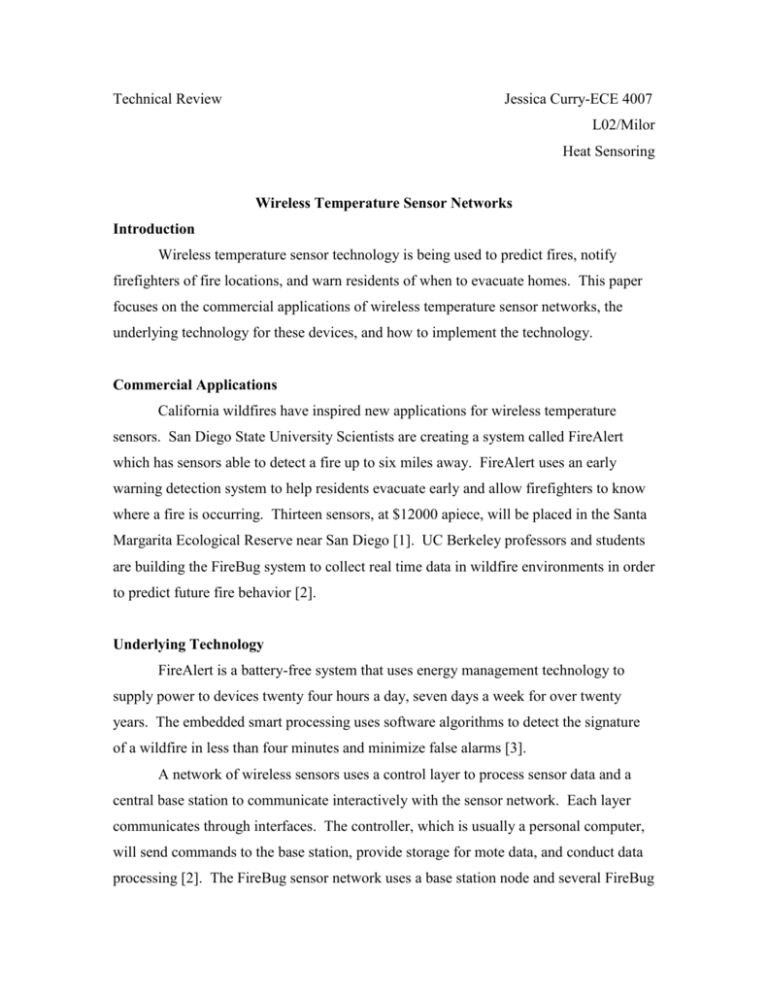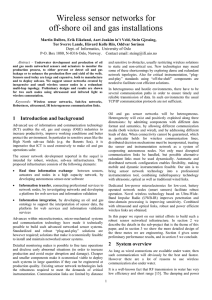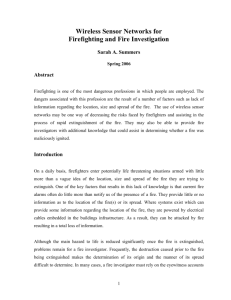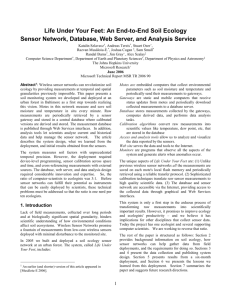Introduction
advertisement

Technical Review Jessica Curry-ECE 4007 L02/Milor Heat Sensoring Wireless Temperature Sensor Networks Introduction Wireless temperature sensor technology is being used to predict fires, notify firefighters of fire locations, and warn residents of when to evacuate homes. This paper focuses on the commercial applications of wireless temperature sensor networks, the underlying technology for these devices, and how to implement the technology. Commercial Applications California wildfires have inspired new applications for wireless temperature sensors. San Diego State University Scientists are creating a system called FireAlert which has sensors able to detect a fire up to six miles away. FireAlert uses an early warning detection system to help residents evacuate early and allow firefighters to know where a fire is occurring. Thirteen sensors, at $12000 apiece, will be placed in the Santa Margarita Ecological Reserve near San Diego [1]. UC Berkeley professors and students are building the FireBug system to collect real time data in wildfire environments in order to predict future fire behavior [2]. Underlying Technology FireAlert is a battery-free system that uses energy management technology to supply power to devices twenty four hours a day, seven days a week for over twenty years. The embedded smart processing uses software algorithms to detect the signature of a wildfire in less than four minutes and minimize false alarms [3]. A network of wireless sensors uses a control layer to process sensor data and a central base station to communicate interactively with the sensor network. Each layer communicates through interfaces. The controller, which is usually a personal computer, will send commands to the base station, provide storage for mote data, and conduct data processing [2]. The FireBug sensor network uses a base station node and several FireBug Technical Review Jessica Curry-ECE 4007 motes, which are each equipped with five sensors that include temperature and humidity, barometric pressure, GPS, an accelerometer, and light intensity. The mote network is operated by a command center passing commands through the base station. Each mote sends the data from its sensors back to the base station which relays the data back to the command center where data is then stored and processed [4]. Implementation Firebug uses Surge software, a java program for displaying multihop routing topology in sensor networks. Surge detects all motes in the wireless network, displays the mote identification number, and presents the number of messages sent from each mote [2]. The multihop software uses the shortest-path first algorithm with a single destination node and active two-way link to find the router for receiving and transmitting packages [5]. MH6 is the self-organizing network routing protocol. Each sensor uses a Leadtek 9546 GPS receiver, which has an external antenna mounted to a sensor board. The software for programming the motes uses low level TinyOS embedded operating system to process the original message and route message [2]. Multiple levels allow for different applications to take place. Some components will process sensor readings, filter and distill data streams for the application, acquire the radio channel, and frame data streams into packets that receiving motes will recognize. A typical top-level application will receive and process a stream of filtered sensor readings and then deliver important messages to the network. The notification messages are received and then transmitted to the other motes [6]. References [1] Ivanhoe Broadcast News, “Fire Sensors-Ecologists Deploy Wireless Sensors for Early Detection of Wildfires,” [Online Document], 1 Sep. 2005, [cited 1 Sep. 2008], Available HTTP: http://www.sciencedaily.com/videos/2005/0901-fire_sensors.htm [2] FireBug Wildland Fire Monitoring System, “Design and Construction of a Wildfire Instrumentation System Using Networked Sensors,” [Organization Website], [cited 1 Sep. 2008], Available HTTP: http://firebug.sourceforget.net/ [3] Ambient Control Systems, “Detection Products,” [Company Website], [cited 1 Sep. 2008], Available HTTP: http://www.ambientalert.com/fa_systems/fa_detect.html [4] G. Martin, “An Evaluation of Ad-hoc Routing Protocols for Wireless Sensor Networks,” B.S. dissertation, Dept. Software Eng., Newcastle Univ., Newcastle, U.K., 2004. [5] C. Shuai, Z. Xianxin, C. Lingling, and L. Xiaowei, “Temperature measurement through wireless sensor networks,” Proceedings of the SPIE, 2006, vol. 6280, pp. 62801J.1-62801J.7. [6] D. Culler, D. Estrin, and M. Srivastava, “Overview of Sensor Networks,” IEEE Comput. Special Issue in Sensor Networks, vol. 37, no. 8, pp. 41-49, Aug. 2004.














